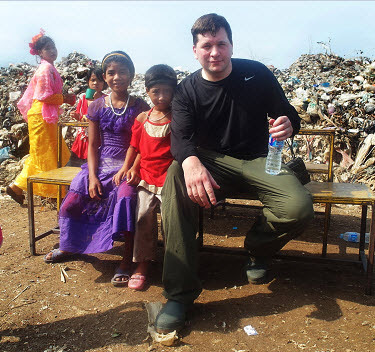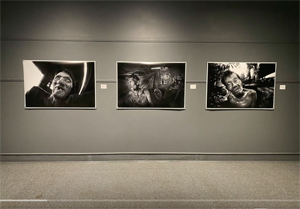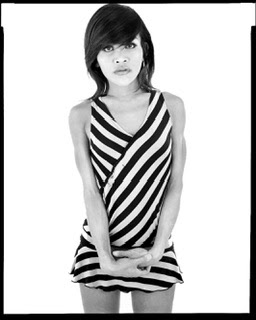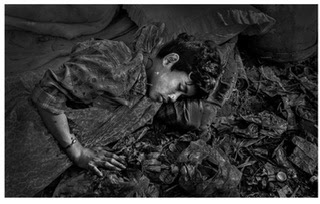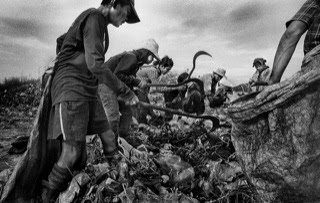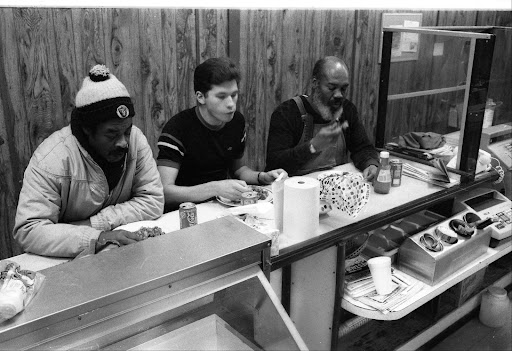Have 2 FACEBOOK people talking about the Jack shot and some of the other photos I linked. Find it rather interesting, thou I think they are over analyzing. Lots of fancy wordy verbage going on, not sure how much is relevant. Some of it reminds me of the BS arty farty artist statements you see so often in galleries. Still it is nice that they noticed :). For me the pictures are much simpler, they tell the stories of forgotten lives, they bring awareness to those lives with the hope of helping to improve or partly eliminating those harsh worlds. For me the pics about the people, their lives, not the arty stuff. Guess we disagree there, I sort of got booted from this discussion! :)
Here is their discussion:
 |
| Jack under the freeway, THE PEOPLE WHO LIVE UNDER THE FREEWAY, Klong Toey Slum, Bangkok Thailand 2019 |
DNJ
I'm curious about your decision to shoot on a slant.
- Gerry YaumAuthorIt is a new way I am looking at the world, a new way of shooting. I now like to photograph while talking to my subject, or allowing them to see my face with no camera in the way. A more face to face interaction, it seems more real. So now when shooting I am often holding the camera up blindly and using wide angle lens close, and using depth of field for focus or auto focus. I am making the selection of the image later, based on the emotions I/we felt at that moment. I think it is about caring less about compositions and more about the reality of the subject now, trying to get a bit into their reality. On a more practical level, I think the lopsided ness of it all is also a bit disturbing, throws off the viewer and is symbolic of the subjects life. The attached slanted photo was made in 2019 as well for THE FAMILIES OF THE DUMP series... Win Lay Auh in the dump at 530am, THE FAMILES OF THE DUMP, Mae Sot Thailand, 2019
- Like
- · Reply
- · 21h
- · Edited
- Like
- · Reply
- · 23h
- DNJ The portrait of him is pretty compelling. That's an interesting way of working. Do they know you are shooting them? (In my opinion, they should give permission but that is your business to deal with.) For me, the image says more straightened out than it does to me at this angle...for me, it appears that the angle was not intentional. That said, if there were 30 strong images like this is in terms of the person and expression, and all of them were skewed, it might work together to make that point better for me, personally. But, on the other hand, it seems like you are making a judgment about them to say that it's "symbolic of the subject's life." Has the person seen it and liked it better that way?
- Like
- · Reply
- · 20h
- GY AuthorDNJ Yes, they knew about the photographs. We are only 3 or 4 feet apart when photographing. I tend to work series for long time. Jack in the photo was a new person to me in 2019 but I have been photographing in that area of the slum s…See more
 Video: Khun BiaGERRYYAUM.BLOGSPOT.COMVideo: Khun Bia4
Video: Khun BiaGERRYYAUM.BLOGSPOT.COMVideo: Khun Bia4- Like
- · Reply
- · Remove Preview
- · 20h
- · Edited
 Video:Facebook: Khun (Mr.) Owen 52GERRYYAUM.BLOGSPOT.COMVideo:Facebook: Khun (Mr.) Owen 52
Video:Facebook: Khun (Mr.) Owen 52GERRYYAUM.BLOGSPOT.COMVideo:Facebook: Khun (Mr.) Owen 52- Like
- · Reply
- · Remove Preview
- · 20h
- GY AuthorHere is Khun Owen, photo made as the same time as the vid above...(straighter comp)
- Like
- · Reply
- · 20h
- GY AuthorCWI try not to over analyze it to much...I just try to tell the story of the people. It seemed to fit Jacks story.. More Owen photos are here if your interested, shot the same time. http://gerryyaum.blogspot.com/2019/12/here-are-some-new-p…See more
 Khun Owen 52, New THE PEOPLE WHO LIVE UNDER THE FREEWAY PhotosGERRYYAUM.BLOGSPOT.COMKhun Owen 52, New THE PEOPLE WHO LIVE UNDER THE FREEWAY Photos
Khun Owen 52, New THE PEOPLE WHO LIVE UNDER THE FREEWAY PhotosGERRYYAUM.BLOGSPOT.COMKhun Owen 52, New THE PEOPLE WHO LIVE UNDER THE FREEWAY Photos- Like
- · Reply
- · Remove Preview
- · 3h
- GYAuthorCW thanks Cary for your thoughts....never thought too much about the tech stuff...just thought of Jack and Owen and what their lives were like, telling their story effectively....the rest sort of fell into place...Hope to go back in Feb for the first time in 2 plus years and continue telling their stories. Hope they are safe and alive, in the slum people die often...Sometimes I go back ask about people and am informed they have died...2 men I photographed in Klong Toey, have died...
- Like
- · Reply
- · 2h
- · Edited
- CW - DNJ What you're describing, Diana, for me is what photographically speaking I characterize as a "tyranny of convention" - of framing, of presentation, of rectilinearity (and maybe one of those Frames discussion topics!). With exception of post-shooting circular and oval matting, photography has primarily echoed the cameras and viewfinders even to the present time, as well as in terms of lenses, for which "normal" is the term applied to the most commonly employed lens. So-called official manuals and guide books, among other advisories, would recommend holding the camera both steady and level. Deviations, as often occurs even here on Frames when horizons are slightly askew, are assumed to be faults.For outdoor photography receding verticals for tall buildings would only occasionally be employed by professionals. They were almost always shot at a level from an adjacent building, with only slight darkroom correction needed if it had not already been made with the adjustments possible on a larger format view camera. For small camera work, such as Garry Winogrand's street photography or Eugene Richard's indoor documentary work, as in his 1978 "Dorchester Days," tilting was sufficiently infrequent that it would invariably elicit commentary specifically about that point.Further afield, so to speak, was the possibility of tilting not only the content within the frame, but the frame itself, which I'd explored at end of the last century: a separate story.I agree with you about the desirability of seeing such matters in multiples to help clarify the intentionality. Paul Strand's singular New England church steeple made it a startling exception in his work.
- Like
- · Reply
- · 2h
- · Edited
- DNJ - CW I suppose you might be right. Although, I am not too big on photographic convention in general; how I worked in the darkroom was the one that never wanted to do a "normal" print treatment, and can pretty much alter anything in photoshop (while drunk and sleeping), and often have a million layers of alterations in my images to get them exactly how I want them...Yet, despite my contrary nature, seeing this as a one-off at that angle didn't really work for me personally. I took it and rolled, filled in the blank spots using CAF and I liked it better. I, personally, would make a different crop on it if it was mine. I don't know, I feel like the angle induces a judgment of the person in the viewer. Yep, as I said, maybe if there were 20 like that, strong portraits and not all junkies, I would feel differently. Maybe I would feel differently if he had not told us the guy was a junkie, or if he had not said he was trying to influence the viewer about the person's station in life...which is something I say with some trepidation because, for me, concept is king and dictates everything about how I make any given body of work, and so it feels terrible to say I dislike this slanted when he is working to his concept.

- Like
- · Reply
- · 2h
- CWPerhaps ironically the second photo of him with straighter comp seems even more judgmental to me, as though virtually catatonic, and his legs hardly distinguishable from the wood they're resting on. Both images, I think, resist quick responses, as does the entire series of people spending their lives growing up and living lives among garbage, as a critique and indictment of civilization itself. "Reading" the image strictly as an image, D, I'd agree that it does "induce a judgement of the person," but not necessarily from the overall angle, which I would say is countered by the man's head and torso that are at the center of the image, and are vertically positioned in relation to the frame edges. More for me, though is the overall darkness, and the ambiguity of an almost metallic appearing left hand holding something that suggests a hammer held, or that has been forced against his head. The curving beams he's positioned against, and the curved windows, could easily suggest being indentured below deck on an oar-powered ship.















